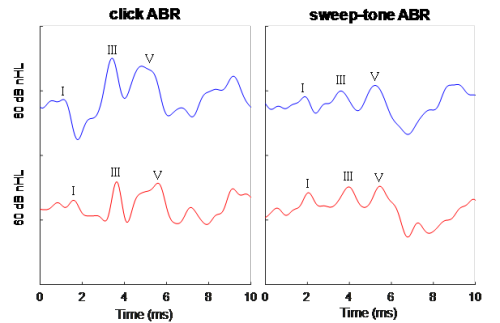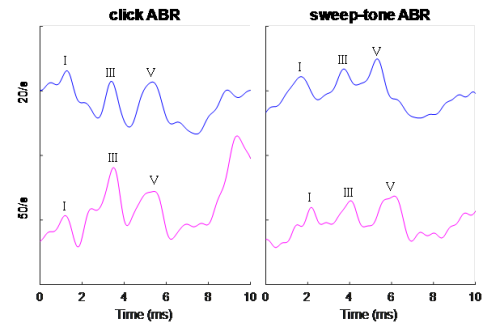Researchers Design a Sweep-Tone Stimulus Evoke the ABR Signal for Hearing Loss Detection
Date:21-02-2020 | 【Print】 【close】
Auditory brainstem response (ABR) are very small electrical voltages originating from the auditory nerve and brainstem, which is an objective method to detect hearing loss.
The ABR evoked by click is generally considered as the gold standard in clinical practice. However, due to the delay characteristics of the human cochlear traveling wave, the click stimulus cannot excite the entire cochlear basilar membrane at the same time, which causes phase cancellation of the evoked ABR signal and the attenuation of the ABR amplitude.
So the click ABR is mainly used to assess high-frequency hearing level in the clinic.
In order to compensate this limitation, a research team from the CAS Key Laboratory of Human-Machine Intelligence-Synergy Systems, Shenzhen Institutes of Advanced Technology, Chinese Academy of Sciences, designed a sweep-tone stimulus that reconstructs the occurrence time of different frequency components with regard to the delay characteristics of the cochlear basilar membrane, and used it to evoke the ABR signal.
The proposed sweep-tone stimulus theoretically could stimulate the neural units throughout the basilar membrane simultaneously, thus avoiding phase canceling effects of the evoked ABR signal.
For testing the efficiency of the sweep-tone ABR, the team invited 5 adults with normal hearing as the subjects to carry out the experiment. Subsequently, they compared the performance of the proposed sweep-tone ABR and the conventional click ABR at different stimulus levels and stimulus rates, respectively.
The experimental results showed that the waveform morphology of the sweep-tone ABR was better than that of the click ABR across different stimulus levels and stimulus rates. Moreover, they have compared the sweep-tone ABR and the click ABR after different sweeps and found that the sweep-tone ABR occurs faster than the click ABR, which means that using the sweep-tone stimulus could save test time for the ABR signal acquisition compared to the click stimulus.
Although waveform morphology is a subjective parameter, it is the primary index based on the ABR waveform for clinicians. In summary, the sweep-tone stimulus is found to be significantly more efficient than the traditional click stimulus when recording ABR in normal-hearing adults.
For further research, the team intend to perform experiments to test the effectiveness of the sweep-tone ABR in hearing-impaired adults and infants, respectively.
The study “Comparing Auditory Brainstem Responses evoked by Click and Sweep-Tone in Normal-Hearing Adults” has been published in 41st Annual International Conference of the IEEE Engineering in Medicine and Biology Society (EMBC), which was held at Berlin, Germany, 2019.

Fig 1. The temporal waveform of the click and the sweep-tone stimuli.(Image by Dr. JIANG Yanbing)

Fig 2. Schematic diagram of experimental process.(Image by Dr. JIANG Yanbing)

Fig 3. The waveforms of click evoked ABR (left) and sweep-tone evoked ABR (right) obtained at 80 and 60 dB nHL.(Image by Dr. JIANG Yanbing)

Fig 4. The waveforms of click evoked ABR (left) and sweep-tone evoked ABR (right) obtained at the rates of 20/s and 50/s.(Image by Dr. JIANG Yanbing)

Fig 5. The waveforms of click evoked ABR (left) and sweep-tone evoked ABR (right) obtained after 1500 and 3000 sweeps.(Image by Dr. JIANG Yanbing)
CONTACT:
ZHANG Xiaomin
Email: xm.zhang@siat.ac.cn
Tel: 86-755-86585299